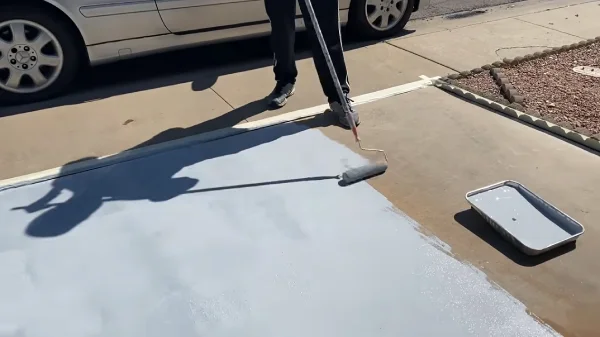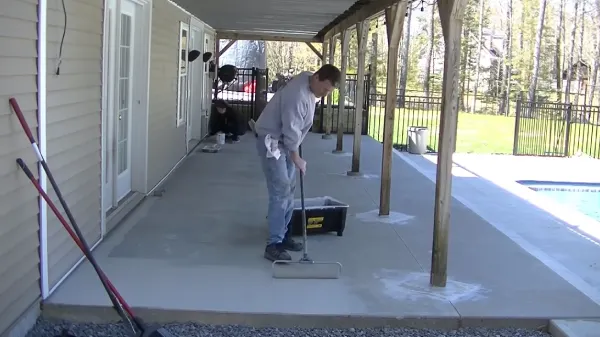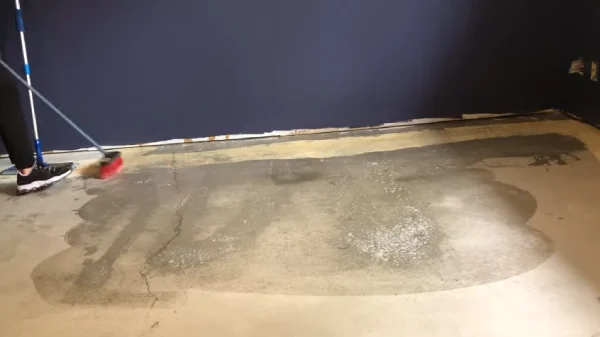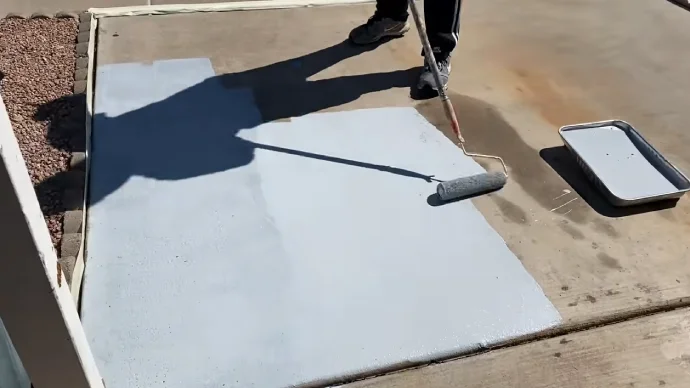Last Updated on January 11, 2023
Concrete sealer is a great way to protect painted concrete surfaces from moisture damage and extend the life of your paint job. Not only does sealing painted concrete improve its durability and make it easier to clean, but it can also add an extra layer of protection from fading, cracking, staining, and other forms of damage.
Applying sealant to concrete is a straightforward process but it’s important to prepare the surface properly before beginning. In this blog post, we’ll discuss the advantages of sealing painted concrete and steps for applying sealant correctly so that you can maintain a beautiful looking surface for years to come.
Advantages of Sealing Painted Concrete
Improved Durability
Preventing Fading, Cracking, and Staining
Sealing painted concrete is an essential part of protecting it against common forms of damage such as fading, cracking, and staining. The sealant acts as a barrier between the paint and outside elements which prevents them from damaging the surface underneath.
Additionally, sealants also act as a waterproof barrier which prevents moisture from entering into cracks in the concrete which could lead to further issues such as mold growth or structural damage. Sealants are also designed to have UV blockers so that sunlight won’t cause fading over time. This allows your paint job to remain looking vibrant and new for much longer than without sealing it first.
Making Surface Easier to Clean:
Another advantage of sealing painted concrete is that it makes the surface much easier to clean. The sealant creates a slick surface that dirt and other materials have difficulty sticking too.
This means that any spills or messes on your painted concrete will be much easier and faster to wipe up then if you had left it unsealed.
Furthermore, if you select a higher quality sealant it could even repel liquids so they never even touch the surface making clean up even simpler.
Enhancing Color and Shine:
The final advantage of sealing your painted concrete is that it can actually enhance the color and shine of the paint beneath it.
Certain sealants are designed with special additives such as reflective particles or dyes that serve two purposes; one being adding an extra layer gloss or sheen to provide better aesthetic appeal while simultaneously reflecting more light back onto itself making colors look brighter and more vibrant than before.
Plus, these effects will last much longer than they would without being sealed as well since they won’t be exposed directly to things like sunlight or wear-and-tear from foot traffic like an unsealed painting would be exposed too
Increased Protection from Moisture Damage
Sealing painted concrete can help keep out moisture and protect your surface from water-related damage. When applied correctly, sealant creates an impenetrable barrier that prevents water from getting inside and damaging the underlying material.
This helps to protect against mold, mildew, and algae growth which can cause serious damage to paint surfaces. It also reduces staining which can occur when debris or liquid spills are left on the surface for too long. Sealant makes it easier to clean up messes without leaving behind permanent marks or discoloration.
Another advantage is that sealant can protect against freeze-thaw cycles that lead to cracking and subsidence in concrete surfaces. By sealing off areas exposed to extreme weather conditions, you can prevent these issues before they become severe enough to require costly repairs or replacements.
This can save you money in the long term by protecting your surface against structural damage due to climate changes over time.
Reduced Maintenance Costs Over the Long Run
By using sealant on an existing painted concrete surface, you can reduce the amount of time needed for regular maintenance tasks such as cleaning and reapplication of paint or stain every few years.
Sealants form a protective layer that resists abrasion, dust build-up, UV rays and other elements that contribute to fading or discoloration in paints and stains over time.
Not only does this make it easier to keep your surface looking fresh and new but it also reduces costs associated with repainting or restaining due to fading or wear-and-tear over time.
Steps for Applying a Sealant to Painted Concrete Surfaces

Preparation Steps
Clean and Repair the Surface as Necessary
Before applying a sealant to a painted concrete surface, it is important to ensure that the surface is clean and free of any dirt, debris, or other contaminants. If needed, any cracks or chips should be filled and repaired with a patching compound. Additionally, any loose paint should be scraped away to provide a smooth surface for the sealant to adhere properly.
Remove Any Wax, Grease or Oil with a Detergent and Warm Water Mixture
It is important to remove any wax, grease or oil on the surface before applying a sealant in order to achieve an optimal bond between the sealant and the concrete.
To do this, mix a detergent with warm water and gently scrub the area using a soft bristled brush. Once done, rinse off the mixture with clean water and allow the surface to fully dry before continuing.
Allow the Area to Fully Dry Before Continuing
Once all of the preparation steps have been completed it is essential that you allow enough time for the area to completely dry before applying any sealants; otherwise you run the risk of trapping moisture beneath which can cause bubbling or peeling once applied.
It is recommended that you wait at least 24 hours after cleaning before proceeding further in order for your sealant application to be successful.
Additionally, if possible it would be beneficial to allow even more time for drying depending on environmental conditions such as humidity levels or temperature which can affect how quickly moisture evaporates from surfaces.
Application Process
Applying a sealant to painted concrete surfaces is an important step in protecting them from weathering and general wear and tear. It can help keep the paint looking vibrant for many years, and it also prevents dirt and other debris from being able to penetrate the surface of the concrete, potentially causing damage over time. To ensure that your sealant is applied properly, there are three main steps that should be followed:
Apply a Thin, Even Coat With a Brush or Roller
The first step in applying the sealant is to spread it out in an even layer across the entire painted surface, using either a brush or roller. When using a brush or roller, always start at one corner of the area and work outward in a circular motion until all of the paint has been covered.
Make sure to apply enough pressure while doing this so that you don’t leave any gaps where the sealant may not cover. When you’ve finished applying the sealant with a brush or roller, take a damp cloth and lightly wipe away any excess material so that there is only an even layer left on top of the paint.
Make Sure Not to Miss Any Areas When Applying Sealant
It’s very important not to miss any areas when applying sealant, as this could result in areas of your painted concrete being left unprotected against weathering or staining.
Before beginning to apply your sealant, inspect your entire project area thoroughly for any edges or holes where you may have missed spots when painting originally.
Once these areas have been identified, make sure they are filled appropriately before sealing them with your chosen product.
Allow Time for the First Coat to Dry After Application
Once all of your sealant has been applied evenly across your painted concrete surface, allow at least 24 hours for it to dry before attempting any further work on your project area such as painting or staining over it again if desired.
This will ensure that all layers are fully bonded together which will provide maximum protection against weathering and staining over time. Once dry, inspect your project area one final time for any areas that may need additional coats of sealer before continuing with whatever task you were trying to complete prior..
Details About Different Types of Sealers Available for Applying Over Paint on Concrete Surfaces

Acrylics
Acrylic sealers are the most commonly used type of sealers for applying over paint on concrete surfaces. They are inexpensive, easy to apply and offer great color retention. Acrylics come in a variety of finishes, from low-luster to high-gloss.
They work best when applied in multiple thin layers. The downside is that they are susceptible to UV damage, so it’s important to reapply every two years or so for optimal protection. Acrylics generally don’t last as long as other types of sealers and may require more frequent reapplication depending on environmental conditions.
Polyurethane
Polyurethane sealers are highly durable and resistant to many chemicals, making them an excellent choice for protecting concrete surfaces from wear and tear. They can be either water- or solvent-based, with the latter providing superior protection against moisture damage.
Polyurethanes generally provide good color retention and have a glossy finish that is abrasion resistant. However, they are not very flexible so it’s important to use them in areas that won’t experience expansion and contraction due to temperature changes or foot traffic.
Epoxy
Epoxy sealers are extremely durable, resistant to acidic damage, and provide superior coverage when compared to acrylics or polyurethanes. Epoxies can be tinted for a custom look but must be applied by a professional due to their complexity—they require mixing two different components before application, which needs to be done correctly for optimal results. Once cured correctly, epoxies should last 15+ years with minimal maintenance needed in between applications.
Silane/Siloxane
Silane/siloxane sealers offer the best protection against moisture damage because they form an invisible barrier over the surface of the concrete that prevents water absorption while allowing vapor transmission (breathability).
They also protect against mold and mildew growth since they create an environment where spores can’t thrive. When applied correctly, silane/siloxane should last 5–7 years before needing reapplication; however, these sealers take longer than other options to dry so make sure you build in enough time into your project schedule if opting for this type of sealer.
Silicate
Silicate sealers provide effective protection against carbonation damage caused by contact with CO2 particles in air or soil (which can cause spalling).
This type of protective layer is especially important when dealing with outdoor concrete surfaces exposed to harsh weather conditions or acid rain infiltration from nearby industrial areas or power plants; however, silicates aren’t necessarily ideal for all situations due to their expensive cost and difficult application process (because there is no room for error).
If you do opt for using a silicate-based sealer then make sure you hire experienced professionals who know how handle its complex installation process properly otherwise your investment could be wasted without any real benefit being achieved from its use longterm
How do you waterproof a painted surface?

One way to waterproof a painted surface is by applying a clear sealer over the paint. This can be done with a brush, roller, or sprayer. The sealer will help protect the paint from water damage, staining, and fading caused by exposure to the elements.
Before applying any sealer, it is important to make sure the painted surface is clean and dry. Any dirt or debris should be removed before application of the sealer, as this could interfere with its effectiveness.
Once the surface is clean and dry, apply an even coat of the sealer across all painted areas. Allow it to dry completely before exposing it to water or other elements.
Can you put a clear sealer over the paint?
Yes, you can put a clear sealer over paint. This will help protect it from moisture and staining, as well as provide an added layer of protection against fading and wear due to exposure to the elements. Before applying any sealer, it is important to make sure that the painted surface is clean and dry.
Any dirt or debris should be removed before application of the sealer, as this could interfere with its effectiveness. Once the surface is clean and dry, apply an even coat of the sealer across all painted areas. Allow it to dry completely before exposing it to water or other elements.
How long will concrete sealer last?
The length of time that a concrete sealant can last depends on several factors such as exposure levels (direct sunlight versus indoors), climate (humid versus arid), how often it comes into contact with moisture (frequent versus infrequent), type of concrete used (porous versus non-porous) and how well it was applied (evenly vs unevenly).
Generally speaking though, when properly applied in normal conditions using quality materials designed for exterior use, most types of concrete sealers can last between two to four years depending on their type and grade level. Furthermore, most products come with warranties which may offer extended coverage if they are installed correctly according to manufacturer instructions.
Is concrete sealer better than paint?
Concrete sealing is typically considered superior compared to painting when trying to protect exterior surfaces from moisture damage due primarily because unlike paints which merely create a protective barrier against certain hazards like UV rays but not necessarily water-borne elements; concrete seals.
Actually penetrate deep below surface layers forming an impenetrable shield against both physical and chemical influences alike making them more durable in comparison in addition to being easier to maintain since they don’t require periodic reapplication like paints usually do making them much more cost effective in terms of long term upkeep costs which makes them overall more favorable option.
When trying make outdoor surfaces last longer while also looking good aesthetically speaking as well given that many types are available in numerous different colors too so one can choose whatever suits them best aesthetically speaking while still maintaining structural integrity within reason as well in terms of weatherproofing abilities etc.
Conclusion:
Sealing painted concrete surfaces is an effective way to keep them looking their best for years to come. Not only does sealing provide enhanced protection against dirt, grease, oil, water damage, and other environmental elements; but it also helps to preserve the color and shine of your paint job.
Whether you’re painting a driveway or patio area; applying sealant after painting is an essential step in ensuring long-term beauty and protection. By following instructions carefully when applying sealant correctly; you can enjoy the improved durability that comes with sealing painted concrete surfaces.



